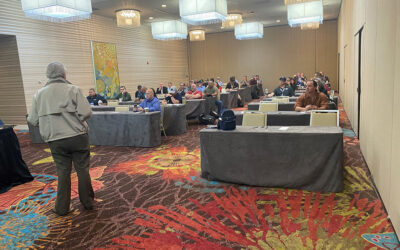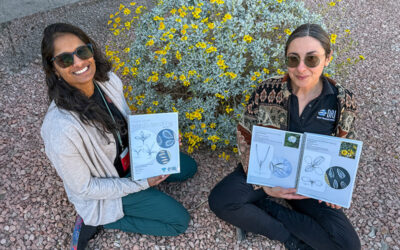What can prehistoric ceramics of the California deserts tell us about the past?
Jan. 5, 2023
LAS VEGAS, NEV.
By Elyse DeFranco
Prehistoric Ceramics
California Desert District
Artifacts
A Q&A With Archaeologist Greg Haynes
DRI archaeologist Greg Haynes, Ph.D., recently completed a synthetic report on the prehistoric ceramic artifacts of the Colorado and Mojave deserts for the Bureau of Land Management’s (BLM) California Desert District (CDD). The CDD manages the 11 million-acre California Desert Conservation Area, which holds cultural artifacts dating back thousands of years. Following a century of research on the prehistoric people and cultures of the Colorado and Mojave deserts of California, this is the first large-scale synthesis focused on ceramics and what they can tell us about the past.
Haynes’ report provides guidance for understanding prehistoric ceramics, identifies research questions for their study, and aids in the evaluation of ceramic-bearing resources for the National Register of Historic Places.
DRI sat down with Haynes to discuss this project, which he calls “one of the highlights of my career.”
DRI: Could you tell me a little bit about your background and how you came to DRI?
Haynes: I’ve been a professional archaeologist for about 35 years. I have a B.A., M.A. and Ph.D. in anthropology and my research focus is on the prehistoric archaeology of western North America. The hunter gatherer populations in the Great Basin, Mojave Desert, and the small-scale agricultural societies on the Colorado Plateau, namely the ancestral Pueblos or Anasazi. I was on staff at DRI as an Associate Research Scientist in archaeology between 1992 to 1998 and returned in 2019.
DRI: And how did you come to be involved with this particular report?
Haynes: The project is focused on creating a new synthetic context for prehistoric ceramics in the deserts of Southeastern California. I was awarded the project in large part because I have a professional background in the area, and I had a nationally recognized ceramic expert in the American Southwest on my team, Dr. Karen Harry, a Professor of Anthropology at UNLV.
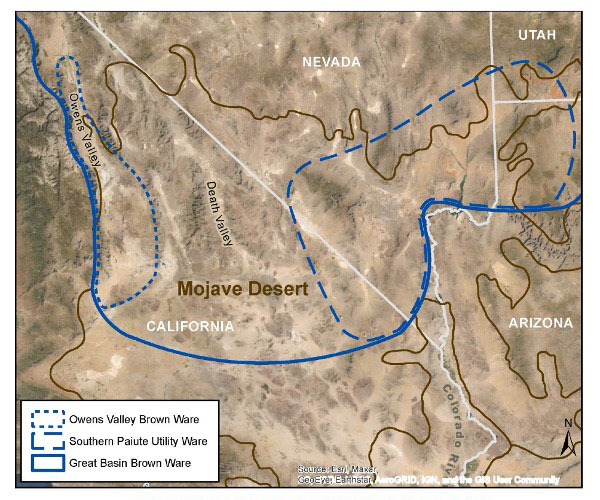
Left: Map of the Mojave Desert region. Right: Great Basin Brown Ware with incised decoration along rim, from the northeastern Mojave Desert.
Credit: Greg Haynes/DRI.
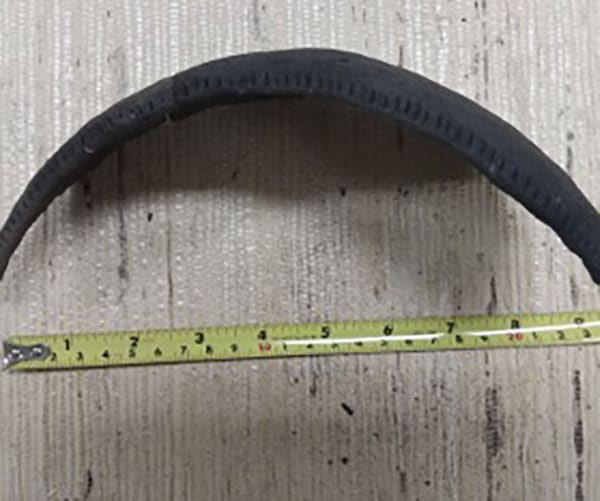
DRI: Why is it important to catalog and identify ceramic artifacts?
Haynes: What the BLM wants to do, and what most archaeologists want to do with ceramic artifacts, is use them to identify cultural and temporal affiliations. Which groups made or used a particular site — that is, you find a pot sherd (piece of ceramic) and you want to infer what archaeological cultures made that ceramic and therefore used or made the archaeological site you’re looking at. They also want to know what time periods those ceramics date to. And many ceramics in the American Southwest are tied to a radiocarbon or tree-ring chronology, so they’re tightly constricted in time and space.
DRI: How are ceramics dated using radiocarbon dating methods or tree-ring chronology?
Haynes: In fact, they can’t be radiocarbon dated. They have to be in direct association with something that can either be radiocarbon dated or be dated through tree rings. For instance, if archaeologists find a pot in a house, and the house has a wooden roof beam over the top of it, the roof beam can be dated through a tree ring chronology (or dendrochronology). And by association, they therefore date the pot at that particular time period.
DRI: And radiocarbon dating only works for things that were previously living, right?
Haynes: Yes, that’s right. Now, there’s another type of dating nowadays called optically stimulated luminescence dating (OSL). And that you can use to actually date the ceramic itself, and as springboard projects develop from this particular one, I hope to learn more about OSL and perhaps use our own OSL lab here at DRI.
The important point though, is that the ceramics in the Colorado and Mojave deserts of Southeastern California, are primarily plain wares — they don’t have a lot of diagnostic features on them. And you need diagnostic features to be able to identify different types of pottery, and therefore the people who made them, as well as track them through time. Additionally, most of the pottery you find sits right on the ground surface. And if they are buried, there’s almost no association with organics that can be radiocarbon dated, tree rings, or stratification — that is, buried deposits that are layered so you can see how things change through time. So, they stump people. This inspired the BLM to seek a new synthetic context for these things, and new research directions about how we can use ceramics to tell us about precontact people and time.
DRI: When ceramics are found in the desert today, are they still collected and put into collections?
Haynes: In general, they’re not collected at all. And one reason is that there are hundreds of collections with tens of thousands of ceramic artifacts in repositories across the U.S. The BLM identified 16 repositories in the Western US that hold prehistoric ceramics from lands administered by the California Desert District. And while there is no absolute number of how many pieces of pottery are in those collections, it is tens of thousands — maybe even over 100,000.
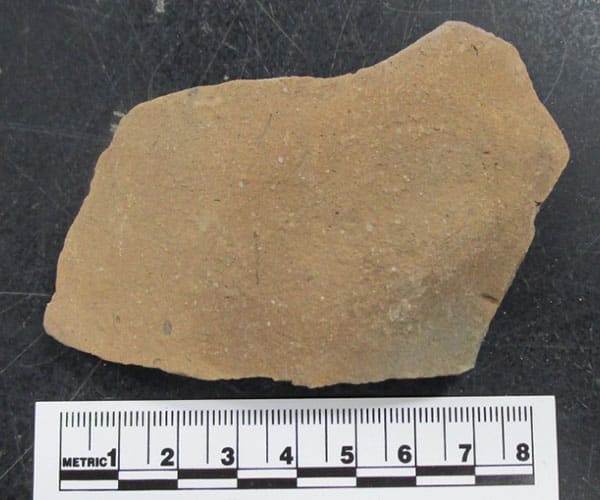
An example of a Tizon Brown Ware body sherd from Arizona. The brown color is derived from residual mountain clays and the temper is visible on its surface.
Credit: Greg Haynes/DRI.
DRI: And how old are some of the artifacts that you documented in this report?
Haynes: They don’t date much before about A.D. 1000. Most of them date no earlier than A.D. 1100 or 1200.
DRI: Would ceramic artifacts last much longer than that?
Haynes: Ceramic artifacts certainly would — they’re fired stone, essentially. Clay molded into something and then fired until they’re essentially pieces of stone.
DRI: When you’re making these associations between the ceramics and the people, how does that work?
Haynes: Well, there are different attributes on the ceramics, like surface colors. For instance, a particular type of ceramic called Lower Colorado Buff ware was known to be made by ancestral Yuman-speaking populations and they have particular types of colors because of their clay sources (buff, orange, or red). And you can also do that with temper (small chunks of rock or other material mixed into the clay to give it some texture, so it doesn’t break apart when it’s being fired and used). The types of clay you might find in Lower Colorado Buff ware is different than the clay in other types of pottery like Tizon Brown ware, which is also found in the Mojave and parts of the Colorado deserts of California, and colored brown. And that’s because it’s made from residual, igneous clays formed in the mountains as opposed to alluvial clays formed on the valley floor near rivers.
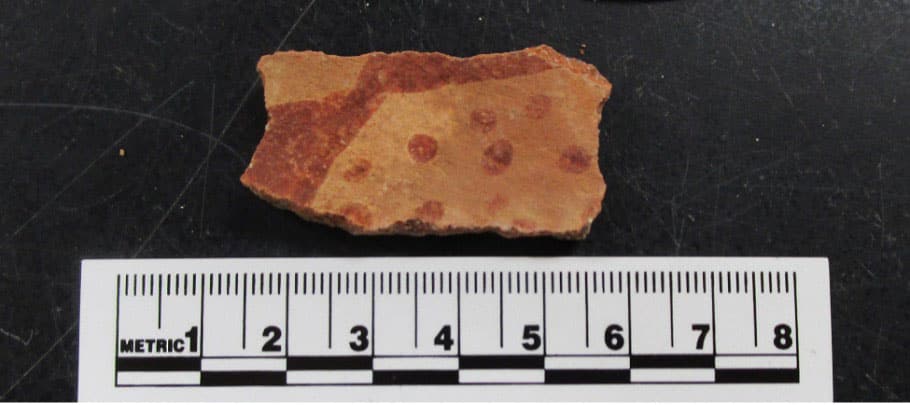
An example of Lower Colorado Buff painted ware from along the Colorado River. It is a red-on-orange bowl sherd with decorated elements on the interior of the vessel.
Credit: Greg Haynes/DRI.
DRI: And what can we learn from these artifacts?
Haynes: Well, what the BLM wanted to learn is, can these plain wares in the Mojave and Colorado deserts of southeastern California actually tell us who was at a site and at what time? That can be done to some extent, but it can’t be done with a lot of detail. So, if you find a site that has a whole bunch of Lower Colorado Buff Ware you can say, okay, the people who lived here were ancestral Yuman-speaking folk, but these same ceramic artifacts have not been tied to a very good chronology. You can’t tell when the site was occupied based on the ceramics, unfortunately. And people have tried to do that for years, but there simply has not been enough radiocarbon dating or stratified deposits associated with those ceramics to track them through time. OSL offers an opportunity to do that, but it has to be fairly widespread — it would take a lot of ceramic artifacts to develop a well-established chronology for plain ware artifacts.
DRI: What do you mean by “wares”?
Haynes: A ware is a type of ceramic that is made by a particular prehistoric people. If you were an archaeologist, however, we could debate what a ware is for quite a long time. I’ll just leave it at that simple, big idea.
DRI: I think you touched on this, but why are the ceramic resources in the Colorado and Mojave Deserts difficult to characterize and differentiate?
Haynes: It’s because they don’t have a lot of distinguishing attributes on them, like painted motifs. For instance, if you find a painted circle or a square on a piece of pottery that’s made in one location, but you don’t find it in the next region over, that may be related to cultural differences. For plain wares, there’s not a lot of decoration, they’re just plain wares, very utilitarian. So that’s what makes them difficult and the fact that they have not been tied to a well-established chronology. And we’re often working with just little fragments of ceramics, rather than large pieces or entire vessels.
Another important point about the ceramic context is that you will not be able to learn much about the ceramics in terms of culture and history unless you examine attributes that change through space and time – like one single attribute, how it changes or varies through time and where you find it. So, one thing you could look at are changes in rim morphology or shape over space and time. Or you could look at the distribution over space and time of stucco (something put around the base of a pot, presumably to strengthen it). Or you could source these ceramics using specialized techniques to identify their geochemical signature or fingerprint, and see how far and wide, through space and time, that geochemical signature or fingerprint can be found.
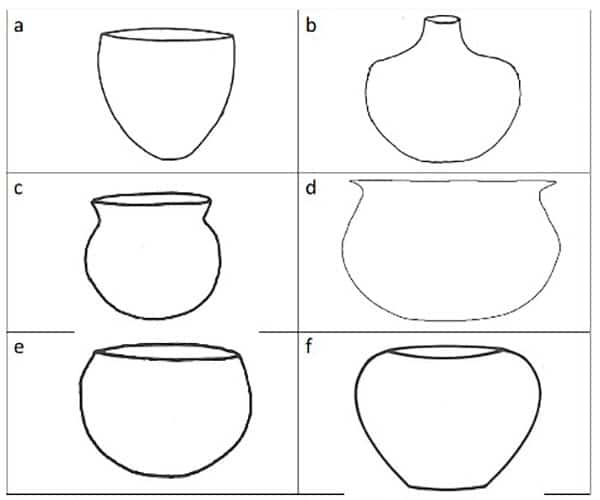
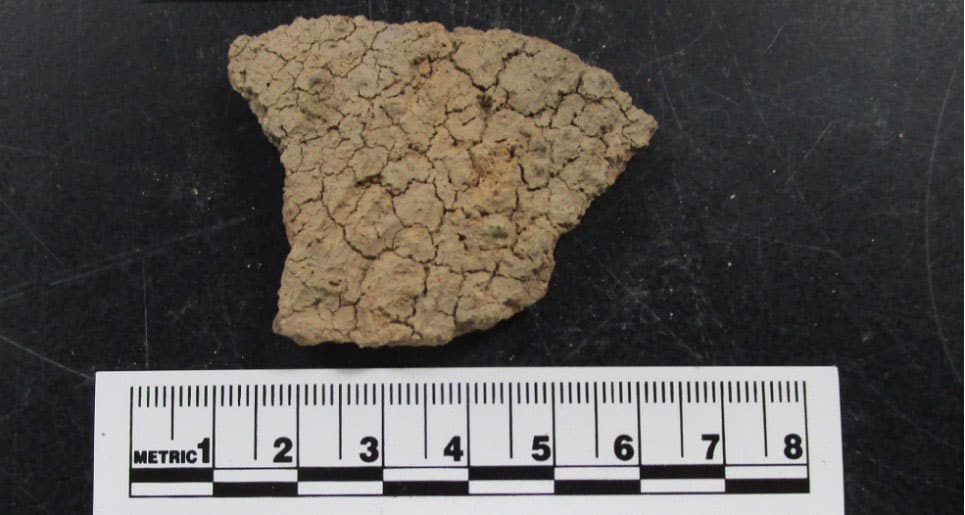
Top: Rim morphologies: a. straight walled; b. chimney neck; c. outward/gently recurved; d. outward flaring/exaggerated recurved wall; e. inward/gently recurved wall; f. inward flaring/exaggerated inverted wall.
Bottom: An example of a Lower Colorado Buff plain sherd from along the Colorado River. It has a thick stucco applied to its exterior.
Credit: Greg Haynes/DRI.
DRI: And by fingerprint, you mean a particular type of clay?
Haynes: That’s correct. You can do the same kind of analysis with what’s called burnishing, where the inside or the exterior of the pot is blackened, and then it’s polished. Where do you find burnishing, through space and through time?
DRI: Did you learn anything new or surprising while preparing this report?
Haynes: Part of the project was to go to a number of ceramic repositories and look at some of these collections. And I chose four museums to go to because they had by far the most ceramics. When you look at collections like that, you run across some incredibly interesting things that are just startling. For instance, I was at the Imperial Valley Desert Museum in El Centro. I was given this bag of prehistoric ceramics and they were Lower Colorado Buff ware, and I thought, “These are really weird — something’s wrong with them.” It was like the pottery itself had decorative waves in the clay, but they were clearly natural. So, I put the bag away because I was just confused by it. And I looked through other bags and looked at different pottery sherds. And the last day of the last hour, I came back to this bag because I’m just completely stymied by it. And I opened it up and looked at it and it dawned on me that this is an unfired pot. They had molded this either around the inside or the outside of a pot, but never fired it. And so, it was just natural clay shaped into a vessel that had somehow preserved on the surface.
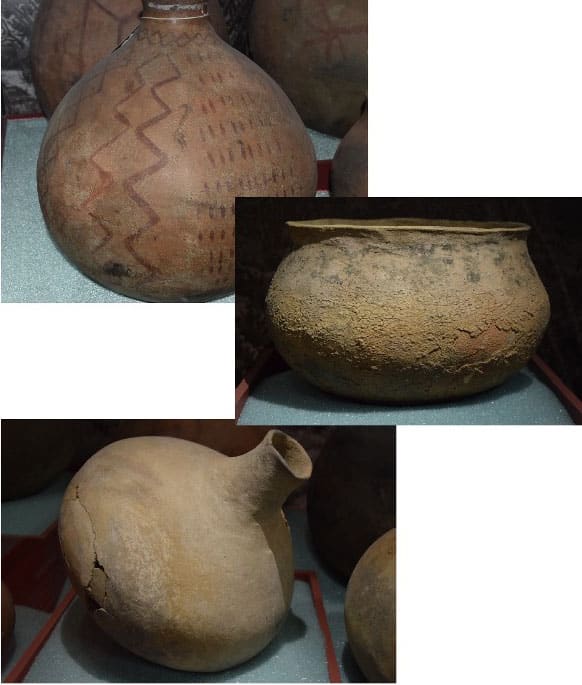
Examples of LCBW vessels on display at the Imperial Valley Desert Museum (TOP: red-on-buff globular jar [olla] with chimney neck, medium to large; MIDDLE: flower pot recurved rim jar, medium to large, with stucco application; BOTTOM: globular [water] jar with chimney neck, medium to large).
Credit: Greg Haynes/DRI.
DRI: So, it just kind of baked in the sun naturally?
Haynes: Exactly. Another bag of pottery I was looking at was in the San Diego Museum of Us and it was from a collection obtained from the Cronese Basin, just west of Baker, California. I looked at these potsherds, and they were really grey and crumbly. And they were painted with black designs. I looked at them and thought “This is weird. I don’t know what this is.” So, I put it away. And I came back to it. And it dawned on me that whoever made this piece of pottery in the Cronese Basin was trying to mimic an Anasazi black-on-grey ware. They were trying to mimic a pottery vessel made perhaps hundreds of miles away. It was startling.
That was really one of the highlights of my career here at DRI.
DRI: And how will this report be used by the Bureau of Land Management?
Haynes: It’s been distributed to all the BLM field offices in the CDD and used as a synthetic overview. It also builds consistency for recording these artifacts in the field. When archaeologists go out and conduct inventory for regulatory compliance purposes under the National Historic Preservation Act, it aids them in recommending a ceramic-bearing site eligible or ineligible for the National Register of Historic Places. In addition, it can also be used by investigators to contextualize the ceramics in Southeastern California. And then offers a chapter on new research directions for their analysis.
DRI: Any final thoughts?
Haynes: Well, it was a tough project for two years. But it was incredibly fun to do — one of the highlights of my career.
We’re (the project principals) planning an invited symposium in 2024 in Riverside, California to discuss these plain wares with other archaeologists and other specialists, as well as Native American tribal members.
More Information
The technical report is the property of the BLM-CDD and will become available in the future on their website.
